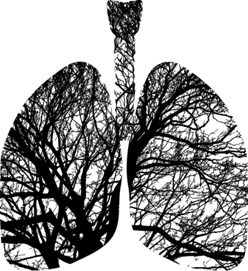Archives
Emphysema vs. chronic bronchitis: Understanding the differences
 Emphysema and chronic bronchitis are lung conditions under the term chronic obstructive pulmonary disease (COPD). Symptoms can be similar between the two, like shortness of breath and wheezing, but they are different conditions. Emphysema is a lung condition where the air sacs -- or alveoli -- become damaged. These air sacs supply oxygen to the blood, so when they are damaged, less oxygen can enter the blood. Chronic bronchitis is a lung condition that destroys tiny hairs, called cilia, in the airways of the lungs. The airways then become inflamed and narrower, making breathing difficult.
Emphysema and chronic bronchitis are lung conditions under the term chronic obstructive pulmonary disease (COPD). Symptoms can be similar between the two, like shortness of breath and wheezing, but they are different conditions. Emphysema is a lung condition where the air sacs -- or alveoli -- become damaged. These air sacs supply oxygen to the blood, so when they are damaged, less oxygen can enter the blood. Chronic bronchitis is a lung condition that destroys tiny hairs, called cilia, in the airways of the lungs. The airways then become inflamed and narrower, making breathing difficult.
The symptoms of emphysema may include:
- being short of breath during everyday activities and exercise
- coughing daily or almost every day
- wheezing
- rapid breathing and heartbeat
- barrel-shaped chest
- fatigue
- difficulty sleeping
- weight loss
- heart issues
- depression
- anxiety
- wheezing
- chest pain or discomfort
- blueness in the fingernails, lips, or skin due to a lack of oxygen in the blood
- crackling breathing sounds
- swollen feet
- heart failure
- shortness of breath or difficulty breathing
- People may have chronic bronchitis if they have a cough that produces mucus for three months or longer per year over the course of two years.
The symptoms of chronic bronchitis may include:
Similarities
Chronic bronchitis and emphysema "often occur together" and make up COPD. Smoking is a leading cause of both conditions. The American Lung Association says cigarette smoking causes as much as 90% of all COPD cases. Family history of lung disease and high exposure to toxic fumes or secondhand smoke can contribute to both. Nevertheless, both conditions make breathing harder, lead to shortness of breath, coughing, wheezing and can eventually lead to heart issues.
Neither condition is curable. Treatment can manage symptoms and are similar, including bronchodilators and other steroids and medication to open airways and alleviate coughing. Oxygen can help people breathe and carry out their everyday activities. Pulmonary rehabilitation from a care team, and lifestyle changes – like stopping smoking and avoiding air pollutants and secondhand smoke -- can help systems from flaring.
Other treatments are more severe. While there is no cure except prevention (of smoking, for example), there are many tracts that may lead to some relief. For those afflicted, controlling the controllables can have a tremendous impact on quality of life.
Want to know more? Click here to read the full article in Medical News Today.
New Developments In Treating and Diagnosing COPD
 Research continues to explore new ways to diagnose and treat COPD, and how medication and pharmacists can serve as valuable resources for COPD patients, providing information about the latest therapies.
Research continues to explore new ways to diagnose and treat COPD, and how medication and pharmacists can serve as valuable resources for COPD patients, providing information about the latest therapies.
New developments in treating COPD are happening on several fronts. For example, research is exploring ways to diagnose COPD early on before significant damage is done, with one path of research focused on non-invasive imaging known as Parametric Response Mapping (PRM). Through PRM, medical professionals can identify small airway abnormalities.
Blood tests, used to target asthma therapy, are also being studied for their use in COPD therapy. The tests measure the number of eosinophils to determine which patients might benefit from biologic drugs called IL-5 antagonists.
Stem cell therapy and less invasive methods of surgery also are being considered. Standard surgery to remove damaged lung sections previously required a large chest incision, but Northwestern Memorial Hospital recently became the first U.S. hospital to use a robotic device, LVRS, requiring only three small incisions to remove damaged lung sections, reducing pain and scarring.
COPD patients may benefit from pulmonary rehab, where patients learn about the benefits of exercise, vaccinations, and nutritional counseling. Further, COPD patients often receive multiple medications and inhalers to treat symptoms, which can lead to misuse and prohibitively expensive therapy.
“New therapies do not directly apply to pharmacists since they are medical procedures rather than medications,” said Lydia Wang, PharmD, a clinical pharmacist coordinator with Atrium Health, “but, pharmacists still play a role in being knowledgeable about these new therapies to better counsel and educate both patients and providers when selecting an individualized course of treatment for patients.”
Wang argues that pharmacists are directly connected to patients and providers, so they can help them select the most effective medication and counsel on proper administration, side effects, and disposal.
“Not only can pharmacists provide extensive education and counseling about the disease state and medications, pharmacists play a crucial role in recommending guideline-directed, evidence-based medications to patients and providers to optimize medication regimens,” said Wang. “Pharmacists play a large role in realizing and recommending pulmonary rehab when appropriate, which can greatly improve patients’ COPD control.”
Non-Smokers Can Get Emphysema From Air Pollution: Study
 Long-term exposure to air pollution is linked to increases in emphysema, according to data produced from between 2000 and 2018. The study funded by NIEHS and the National Heart, Lung, and Blood Institute, the findings of which appeared August 13 in JAMA, adds evidence linking air pollution and emphysema, a lung disease that gets worse over time.
Long-term exposure to air pollution is linked to increases in emphysema, according to data produced from between 2000 and 2018. The study funded by NIEHS and the National Heart, Lung, and Blood Institute, the findings of which appeared August 13 in JAMA, adds evidence linking air pollution and emphysema, a lung disease that gets worse over time.
Emphysema, usually associated with smokers, is a chronic disease in which lung tissue is destroyed and becomes unable to effectively transfer oxygen.
“Air pollution is a significant public health concern around the world,” said Gwen Collman, Ph.D., director of the NIEHS Division of Extramural Research and Training. “It’s been a priority of NIEHS research for many years, so it’s great when we can accelerate our efforts by joining with other NIH [National Institutes of Health] institutes in supporting research on lung disease.”
The study included more than 7,000 men and women from the Multi-Ethnic Study of Atherosclerosis (MESA). Researchers followed individuals with emphysema, analyzing more than 15,000 computed tomography (CT) scans and lung function tests from the nearly two-decade period analyzed.
Over the same period, MESA carefully tracked air pollution in the varied metropolitan regions of Winston-Salem, N.C; St. Paul, Minn.; New York City; Baltimore; Chicago; and Los Angeles.
“These findings may offer one explanation for why emphysema is found in some people who never smoked,” said James Kiley, Ph.D., director of the NHLBI Division of Lung Diseases. “The study’s results, duration, and timing offer insight into the long-term effects of air pollution on the U.S. population.”
Clear and consistent associations between long-term exposure to air pollutants and progression of lung disease were found across the six localities.
Traffic-related air pollutants were identified as affecting emphysema.
“The combined health effect of multiple air pollutants — ozone, fine particles known as PM2.5, nitrogen oxides, and black carbon — was greater than when the pollutants were assessed individually,” said Bonnie Joubert, Ph.D., a scientific program director at NIEHS. “With the study’s long-running duration, repeated CT scans allowed analysis of changes in emphysema over time.”
“Rates of chronic lung disease in this country are going up and increasingly it is recognized that this disease occurs in nonsmokers,” said the study's senior co-author, Joel Kaufman, M.D., from the University of Washington. “We really need to understand what’s causing chronic lung disease, and it appears that air pollution exposures that are common and hard to avoid might be a major contributor.”
Glycopyrrolate Improves Lung Function in COPD, Regardless of Smoking Status
Glycopyrrolate inhalation powder may improve lung function significantly in patients with moderate to severe chronic obstructive pulmonary disease (COPD) regardless of baseline smoking status, according to a study published in Respiratory Research.
COPD develops in almost 50% of smokers, with 42% of all COPD-related deaths attributable to tobacco smoking. About 40% of patients continue to smoke after COPD diagnosis, which can impair treatment efficacy.
Glycopyrrolate inhalation powder is a long-acting muscarinic antagonist medication approved by the United States Food and Drug Administration, given at a dose of 15.6 µg twice daily for long-term maintenance treatment of airflow obstruction in patients with COPD.
Researchers analyzed pooled data from two 12-week studies in 867 patients (57% current smokers; 43% former smokers) to determine the effect of smoking status on the efficacy and safety of glycopyrrolate inhalation powder compared with placebo in patients with moderate to severe COPD.
Researchers found that glycopyrrolate inhalation powder significantly improved all lung function measures, total St. George’s Respiratory Questionnaire (a disease-specific instrument designed to measure impact on overall health, daily life, and perceived well-being in patients with obstructive airways disease) score. Rescue medication use and the incidence of adverse events and serious adverse events was also similar regardless of smoking status.
Current smokers receiving background inhaled corticosteroid therapy in addition to glycopyrrolate inhalation powder had no significant improvements. Also, treatment with glycopyrrolate inhalation powder showed clinically important improvements in COPD assessment test scores, transition dyspnea index focal scores and daily symptom scores in both current and former smokers.
“These data support the use of glycopyrrolate inhalation powder twice daily in patients with moderate to severe COPD regardless of their baseline smoking status, although the magnitude of benefit may differ between current and ex-smokers,” the researchers wrote.
Click here to read the complete article Pulmonology Advisor.
Prevalence of Osteoporosis in COPD Prompts Need for Screening
Osteoporosis is prevalent in patients with chronic obstructive pulmonary disease (COPD) – a prevalence that is similar across COPD populations in many countries, according to a study published in CHEST.
Researchers conducted a systematic review by searching several databases using the keywords “COPD,” “osteoporosis,” “prevalence,” and “risk factor.” Two reviewers then independently screened the data for eligibility, data extraction and quality assessment of the articles.
The combined analyses indicated a pooled global osteoporosis prevalence of 38% and 15% in the control groups. Significant diversity was identified, which analysis significantly associated with the source of patients with COPD. Prevalence did not significantly differ among the five geographical regions: the Americas, Eastern Mediterranean, Europe, South-East Asia, and Western Pacific.
Patients with COPD having osteoporosis was 95%. Significant risk factors for osteoporosis among patients with COPD included body mass index and the presence of muscle loss with aging (sarcopenia).
The investigators also deteremined that individuals with COPD at high risk for osteoporosis should be identified early through screening and strategies aimed at improving or controlling risk factors for osteoporosis should be implemented in the early stages of lung disease.
Click here to read the complete article on Pulmonology Advisor.
Asthma-COPD Overlap in Primary Care: Prevalence and Characteristics
One in five adults diagnosed with asthma, chronic obstructive pulmonary disease (COPD), or both in a primary care setting have asthma-COPD overlap (ACO) based on the criteria established by the Respiratory Effectiveness Group (REG) ACO Working Group, according to a study published in Annals of the American Thoracic Society.
To overcome the scarcity of information about individuals with ACO in primary care, the workgroup conducted a cross-sectional study of patients 40 years old and older with two or more primary care visits during a two-year period.
The data came from the United Kingdom’s Optimum Patient Care Research Database and was used to estimate disease prevalence and describe the characteristics of the condition in patients with COPD, asthma or ACO. The study also compared symptoms among the three.
The study included 2,165 patients (1,015 with COPD, 755 with asthma and 395 with ACO). The overall ACO prevalence was 20% among a patient population with a mean age of 70 among which:
- 40% were women
- 66% were obese or overweight
- 73% were former smokers
- 27% were current smokers.
- 53% had diabetes,
- 36% had cardiovascular disease,
- 30% had hypertension,
- 23% had eczema, and
- 21% had rhinitis.
According to the study, comorbid conditions -- the simultaneous presence of two chronic diseases or conditions in a patient -- were common in patients with ACO:
ACO prevalence was higher in patients diagnosed with both asthma and COPD (32%) compared with patients diagnosed with asthma only (14%) or COPD only (20%). Investigators also found that the significant variation in characteristics of patients with ACO and in the patterns of some of the comorbid conditions suggests that ACO as defined likely comprises a diverse group.
They wrote: “While the use of information recorded by clinicians in primary care offered the opportunity for our results to be more generalizable, our study also highlights the disadvantage of relying on clinical documentation.”
Click here to read the complete article in Pulmonology Advisor.
Determining and Understanding End-Stage COPD
Chronic obstructive pulmonary disease, or COPD, is a progressive condition that gets steadily worse and, over time, causes the body to become less able to take in enough oxygen. Ultimately, this can lead to death. The Centers for Disease Control and Prevention (CDC) says that chronic lower respiratory diseases, including COPD, are the “third leading cause of death in the United States” as of 2014.
Recognizing the end-stage symptoms of COPD can help a person cope and say goodbye to loved ones, make peace with their life, seek hospice care, and discuss their final plans. The following are the signs and symptoms that may indicate that a person is nearing the end of their life.
There are four stages of COPD ranging from mild to end-stage. Until recently, only forced expiratory volume in one second (FEV1) was the test used to show the severity and stage of COPD. FEV1 is a measure of how much air a person can exhale in a single breath. When it falls below 30% of the average amount, a person may be in the end stages of COPD. However, a new standard was adopted after 2011 that examines such factors as shortness of breath, the person's history of acute COPD episodes and the impact of the disease on their life. Per the new stages of COPD, mild stage 1: FEV1, is above 80% -- meaning the individual might not even notice that they have the condition.
Moderate, or stage 2: FEV1, is 50%-80% and is characterized by a chronic cough, excess mucus and shortness of breath. Severe, or stage 3: FEV1, is 30%-50% and is characterized by a chronic cough and struggle to exercise or do daily activities. The individual may also feel tired or sick.
End stage, or stage 4: FEV1, falls below 30%, severely affecting the patient’s daily life. There are two ways to measure this final stage of COPD:
- low blood oxygen, or hypoxemia
- hypoxia, which is low oxygen in the body's tissues
- cyanosis, a bluish hue to the skin due to oxygen deprivation
- chronic respiratory failure, which occurs when the respiratory system cannot take in enough oxygen or release enough carbon dioxide
- difficulty walking
- shortness of breath
- frequent lung infections
- difficulty eating
- confusion or memory loss due to oxygen deprivation
- fatigue and increased sleepiness
- frequent severe flare-ups
- more frequent trips to the hospital
- longer hospital stays
- anxiety or depression
- changes in consciousness
- trouble swallowing
- twitching or muscle weakness
- changes in the way a person breathes, or their pattern of breaths
- increasingly loud breathing
During the latter stages of COPD, a person tends to experience more severe flare-ups. This is often accompanies by more and longer hospital stays.
“Although a person will get a little better between flare-ups, they tend not to return to their previous condition,” Medical News Today reports. Thus, an individual’s health becomes steadily worse with each flare-up, and each flare-up tends to be worse than the last.
Another late-stage symptom is severe limitations in physical activities, including:
Processed Meat Associated with Greater COPD Risk
 Middle-aged women may be at an increased risk of developing chronic obstructive pulmonary disease (COPD) when they have a greater intake of processed meat. In a new international study assessing the 87,000-plus registrant Nurses’ Health Study II data, a team of France- and Boston-based investigators found that processed meat—along with other known risk factors including smoking and obesity—significantly increase middle-aged women’s risk of developing COPD.
Middle-aged women may be at an increased risk of developing chronic obstructive pulmonary disease (COPD) when they have a greater intake of processed meat. In a new international study assessing the 87,000-plus registrant Nurses’ Health Study II data, a team of France- and Boston-based investigators found that processed meat—along with other known risk factors including smoking and obesity—significantly increase middle-aged women’s risk of developing COPD.
Investigators sought to interpret the associated increased risk of COPD with processed meat, as well as the significance of increased risk factors in COPD-susceptible women.
This is especially important because the findings closely follow the classification of processed meat as a carcinogenic by the International Agency for Research on Cancer. Previous research has linked processed meat intake to greater risks of chronic diseases and all-cause mortality, investigators said.
“Regarding lung health, eight studies have reported that frequent processed meat intake was associated with decreased lung function, and greater COPD symptoms, exacerbations, or incidence,” researchers wrote.
In the report, the eight studies were cross-sectional or longitudinal with data collected from among various countries, and generated by men or women with a mean age greater than 65 years old.
According to the researchers, they studied 2,296,894 person-years’ worth of data from the nurses database. They identified 634 incident cases of COPD, while separating the average processed meat intake into intervals of “never/almost never;” less than one serving per week; or greater than one servings per week.
After adjusting for smoking and unhealthy diets, investigators said they found a positive association between processed meat intake of ≥1 serving per week and COPD risk versus never/almost never intake.
When arranged according to smoking or unhealthy diet, only people who smoked most of their lives and women with unhealthy diets had an increased risk of COPD. When adjusted for age, the risk for COPD nearly doubled in middle-aged women with two of the three observed unhealthy lifestyle habits. Among women with all three observed habits, COPD risk was raised nearly seven-fold.
Investigators believe their findings carry major public health implications, as the only currently understood metric for primary COPD prevention is avoidance of exposure to tobacco smoke.
“To our knowledge, only one cross-sectional study has assessed the modifying effects of antioxidant and oxidant intake in the association between processed meat and lung function, but without including the combined effect of unhealthy/healthy diet and smoking,” they said.
The nitrites added to meat products can play a role in an increased inflammatory process.
Investigators said processed meat intake is associated with increased COPD risk, and advised clinicians assess dietary interventions as part of their approach to promoting proper lung health.
Click her to read the full article on HCP Live Network.
Fitness In Middle Age Dramatically Cuts Men's COPD Odds
 Having good heart-lung fitness in middle age could lower men's long-term risk of developing and dying from chronic obstructive pulmonary disease (COPD), a new study finds.
Having good heart-lung fitness in middle age could lower men's long-term risk of developing and dying from chronic obstructive pulmonary disease (COPD), a new study finds.
The study included more than 4,700 healthy middle-aged men in Denmark who were recruited between 1970 and 1971. Their average age at the time was 49. They provided information about their lifestyle habits and medical history, and their heart and lung fitness was assessed. The men were tracked for up to 46 years, with overall follow-up ending in 2016.
When compared to those who had low heart-lung fitness in middle age, COPD risk was 21 percent lower in those who had normal fitness and 31 percent lower in those whose heart-lung fitness was high. The risk of death followed a similar trend. The risk of dying from COPD was also 35 percent lower in those who had normal fitness and 62 percent lower in those whose heart-lung fitness was high. Those who had high fitness levels stayed healthier and had longer lives, as well – up to 1.5 or two years longer, according to the study published online June 18 in the journal Thorax.
The findings suggest that physical activity should be encouraged in adults “to delay development, progression and death from COPD,” said Dr. Gorm Mork Hansen in a journal news release. Hansen is from Herlev-Gentofte University Hospital in Copenhagen, Denmark.
Researchers said their findings add to previous studies that show that high levels of physical activity are associated with a reduced risk of COPD, and that a sedentary lifestyle may speed progression of the disease. However, the study only showed an association and not causation.
Links between heart-lung fitness and COPD aren't clear, but inflammation linked to inactivity may play an important role, according to the researchers.
COPD includes respiratory conditions that narrow the airways, such as emphysema and bronchitis. Smoking is the main risk factor for COPD, the fourth-leading cause of death worldwide, according to the World Health Organization.
Study: Air Pollution Ages Lungs Faster, Increases Risk of COPD
 Air pollution does a lot more damage to people’s lungs than scientists realized, according to a new study recently published in the European Respiratory Journal. Researchers say that they found that pollution ages lungs more quickly and putting people at higher risk of COPD.
Air pollution does a lot more damage to people’s lungs than scientists realized, according to a new study recently published in the European Respiratory Journal. Researchers say that they found that pollution ages lungs more quickly and putting people at higher risk of COPD.
Lung function declines as a part of natural aging, but exposure to particulate matter pollution ages lungs even faster – and the more pollution people are exposed to, the quicker their lungs age. For each additional five micrograms per cubic meter of particle pollution a person is exposed to on average annually, the lungs showed an equivalent of two years of aging, and a reduction in lung function.
Particle pollution is the mix of solid and liquid droplets in the air, according to the US Environmental Protection Agency, coming from dirt, dust, soot or smoke. It comes from coal- and natural gas-fired plants, cars, agriculture, unpaved roads and construction sites. For people living with air that has more than 10 micrograms per cubic meter of particle pollution, their lungs are much worse off. Among those in the most polluted areas, the number of COPD cases was four times higher than if a person lived with smokers, and half that of people who had been smokers.
COPD, chronic obstructive pulmonary disease, is a series of lung diseases that block airflow and make it difficult to breathe. It's the third leading cause of death in the world. Although many with COPD smoked at one point in their lives, it can also be genetic, and it can be caused by a person's environment.
Researchers surveyed more than 300,000 people and participants were given tests to determine their actual lung function. The study went on between 2006 and 2010. The researchers then conducted multiple tests to see how long-term exposure to higher levels of air pollution was linked to the changes in how people could breathe. They factored for people's occupations that may expose them to pollution and to people's exposure to cigarette smoke.
Air pollution causes inflammation in the lungs, which narrows airways and makes it harder to breathe. Air pollution also increases the risk of heart disease, strokes and lung cancer. The test results were even worse for people living in low-income households because of poorer housing conditions, worse diets and more limited access to healthcare.
"Air pollution had approximately twice the impact on lung function decline and three times the increased COPD risk on lower-income participants compared to higher-income participants who had the same air pollution exposure," said study author Anna Hansell, a professor of environmental epidemiology in the Centre for Environmental Health and Sustainability at the University of Leicester.
The number of COPD cases is expected to increase dramatically over the next 10 years, and the rising levels of pollution will likely play a large role in that.
In the United States, earlier studies showed that 141 million Americans living in counties with unhealthy levels of particle pollution or ozone.




